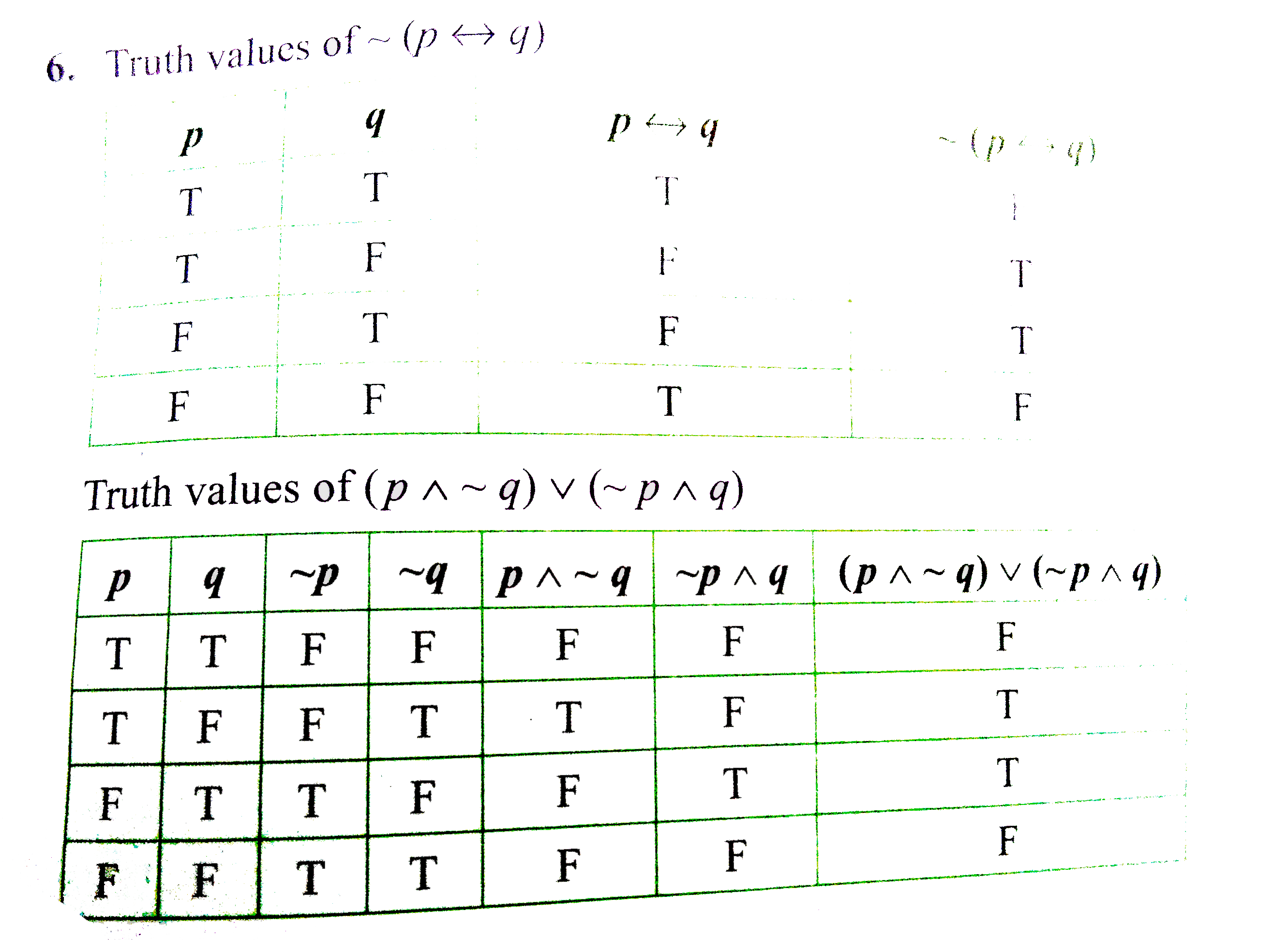Show that ~(p↔q)≡(p∧~q)∨(~p∧q).
The correct Answer is:
Statement ~(p↔q) and (p∧~q)∨(~p∧q) have identical truth values
∴ ~(p↔q)≡(p∧~q)∨(~p∧q)
To show that ¬(p↔q)≡(p∧¬q)∨(¬p∧q), we will use truth tables to verify the equivalence of the two expressions.
Step 1: Define the Variables
Let’s define the variables p and q. Each variable can either be true (T) or false (F). We will consider all possible combinations of truth values for p and q.
Step 2: Create a Truth Table
We will create a truth table that includes the columns for p, q, p↔q, ¬(p↔q), ¬p, ¬q, p∧¬q, ¬p∧q, and finally (p∧¬q)∨(¬p∧q).
| p | q | p↔q | ¬(p↔q) | ¬p | ¬q | p∧¬q | ¬p∧q | (p∧¬q)∨(¬p∧q) |
|---------|---------|---------------------------|----------------------------------|--------------|--------------|----------------------|----------------------|----------------------------------------------|
| T | T | T | F | F | F | F | F | F |
| T | F | F | T | F | T | T | F | T |
| F | T | F | T | T | F | F | T | T |
| F | F | T | F | T | T | F | F | F |
Step 3: Analyze the Truth Table
Now, we will analyze the columns for ¬(p↔q) and (p∧¬q)∨(¬p∧q).
- The column for ¬(p↔q) has the values: F, T, T, F.
- The column for (p∧¬q)∨(¬p∧q) has the values: F, T, T, F.
Step 4: Conclusion
Since both columns match for all combinations of truth values, we conclude that:
¬(p↔q)≡(p∧¬q)∨(¬p∧q)
This proves that the two expressions are logically equivalent.
Let’s define the variables p and q. Each variable can either be true (T) or false (F). We will consider all possible combinations of truth values for p and q.
We will create a truth table that includes the columns for p, q, p↔q, ¬(p↔q), ¬p, ¬q, p∧¬q, ¬p∧q, and finally (p∧¬q)∨(¬p∧q).
|---------|---------|---------------------------|----------------------------------|--------------|--------------|----------------------|----------------------|----------------------------------------------|
| T | T | T | F | F | F | F | F | F |
| T | F | F | T | F | T | T | F | T |
| F | T | F | T | T | F | F | T | T |
| F | F | T | F | T | T | F | F | F |
Now, we will analyze the columns for ¬(p↔q) and (p∧¬q)∨(¬p∧q).
- The column for (p∧¬q)∨(¬p∧q) has the values: F, T, T, F.
Since both columns match for all combinations of truth values, we conclude that:
Topper's Solved these Questions
- MATHMETICAL REASONINGBOOK - CENGAGECHAPTER - MATHMETICAL REASONINGEXERCISE - Exercise 10.2
5 Videos
- MATHMETICAL REASONINGBOOK - CENGAGECHAPTER - MATHMETICAL REASONINGEXERCISE - Exercise (Single)
38 Videos
- MATHMETICAL REASONINGBOOK - CENGAGECHAPTER - MATHMETICAL REASONINGEXERCISE - JEE Previous Year
10 Videos
- LOGARITHM AND ITS PROPERTIESBOOK - CENGAGECHAPTER - LOGARITHM AND ITS PROPERTIESEXERCISE - JEE Previous Year
5 Videos
- MATRICESBOOK - CENGAGECHAPTER - MATRICESEXERCISE - Solved Examples And Exercises
165 Videos
Similar Questions
Knowledge Check
(p∧q)∨(~q∧p)≡
Aq∨pBPC~qDp∧qp∧(q∨r)≡(p∧q)∨(p∧r) is :
AAssociative lawBDistributiveCIdentity lawDAbsorption(p∧~q)∧(~p∨q) is
Aa contradictionBa tautologyCEither (a) or (b)DNeigher (a) nor (b)
~(p→q)→[(~p)∨(~q)] is
View SolutionThe Bolean Expression (p∧~q)∨q∨(~p∧q∨(~p∧q) is equivalent to
View SolutionQuivalent circuit for the logical expression (~p∧q)∨(~p∧~q)∨(p∧~q) is
View Solutionp∨~(p∧q) is a
View SolutionIf p is true and q is false then the truth values of (p↔q)↔(~q→~p) and (~p∨q)∧(~q∨p) are respectively
View Solution
